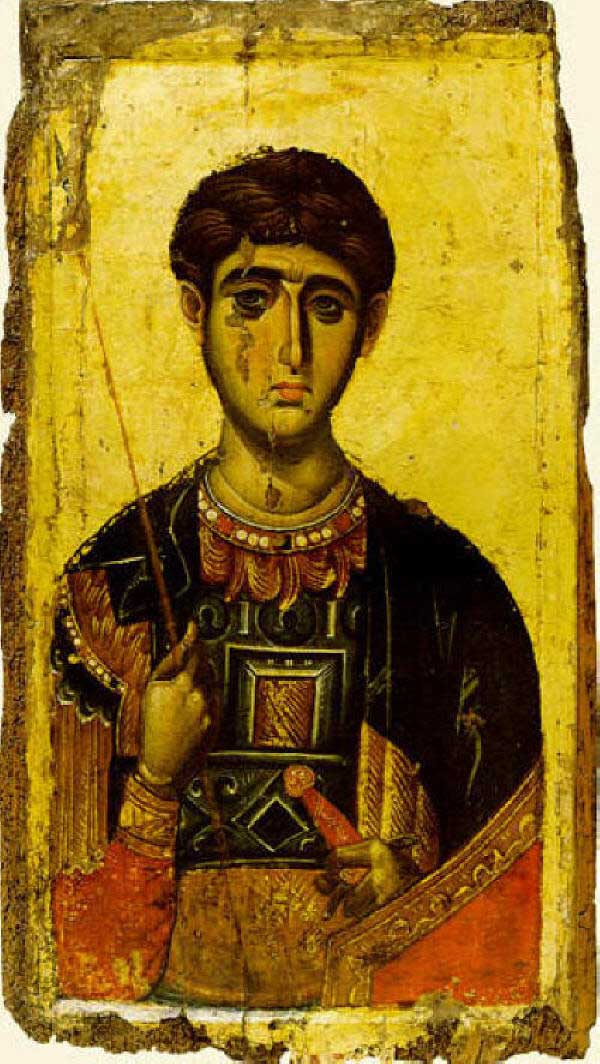 |
|
По-долу:
Виж също:
Храмът "Св. Димитър Мироточиви" е един от символите на град Солун. В него се съхраняват мощите на светеца, пострадал мъченически по времето на император Максимиан (292-311 г.).

Св. великомъченик Димитрий Мироточиви Солунски († 306).
Икона от ХІV в.
Мануил Панселинос от манастира Ватопед в Света Гора
Църквата е построена през V век върху основите на римския затвор, в който е пострадал светецът и където е бил и гробът му.
Бурните събития в този регион могат да бъдат проследени в историята на храма. Между 629 и 639 г. пожар унищожава голяма част от него. Той е възстановен с усилията на жителите на Солун. През 904 г. сарацините превземат града и разграбват църквата. Същото правят и норманите, които се установяват в града през 1181 година.
През 1493 г. храмът е превърнат в джамия от турците.
След освобождаването на Солун през 1912 г. църквата отново става място за поклонение на св. Димитър. При голям пожар през 1917 г., когато са опожарени две трети от града, храмът също е разрушен. Последвалите възстановителни работи възвръщат древната красота на "Св. Димитър".
Днес храмът представлява внушителна постройка. В него са запазени колони от различните периоди от историята му: в подземията може да се видят основите и фрески от първия храм, а в кораба могат да се открият останки от храмови колони или части от стени от различни векове. Всичко това на пръв поглед остава незабелязано за богомолци и посетители, защото църковните архитекти са успели да постигнат пълна хармония между древните останки на храма и съвременните възстановителни работи.
Сега "Св. Димитър" е една от най-красивите църкви в Солун, събрала в себе си цялата история на града.
Жителите на Солун почитат св. Димитър като свой небесен покровител. Всяка година, в деня на неговата памет (26 октомври), се извършва литийно шествие с мощите на Солунския чудотворец.
Св. Димитър е много почитан и в България, затова и много българи се стичат на поклонение пред мощите на светеца в Солун. 
Брой 20 за 1998 година
The basilica of Ayios Demetrios possesses a strong emotional appeal to the people of Thessalonike, while at the same time it constitutes a museum of Byzantine art on account of the successive phases of its building (5th and 7th centuries, and reconstruction in the 20th century). It was erected over the site of the Roman baths where the saint was martyred and where the earliest place of his worship once stood (4th century).
Its form, a five-aisled basilica with an additional transverse aisle in front of the sanctuary, resembles a cross in plan, denoting the site as a place of martyrdom. The sculptured architectural members and marble panelling of the walls vest the monument with the magnificence that befits the martyr Demetrios.
The decoration is complemented with 7th century wall-paintings and mosaics dating from the 5th to the 7th centuries and to the 9th century; they lack iconographic coherence, the main subject being the saint portrayed with the donors of the church or with a variety of other figures.
The mosaics are unique and of particular note in connection with the art of the Early Christian period, for in this instance the principles of Hellenistic art have not been entirely abandoned, although painting is becoming gradually more flat and more abstract.
Underneath the Church of St Demetrios is the place where St Demetrios, Thessaloniki’s patron saint, was martyred.
As the level of the ground gradually rose over the centuries, this area acquired the form of a crypt. According both to tradition and to archaeological findings, it was an old bathhouse, in which Demetrios was imprisoned and eventually martyred in ad 303.
In the 5th century, when the first Church of St Demetrios was built, the site of his martyrdom was incorporated into the church and the fountain was converted into a source of holy water. In the years that followed, the fountain acquired basins, from which the faithful could collect myron, the sweet-smelling oil produced by the saint’s relics. The crypt filled up with earth during the period of Ottoman rule and was not rediscovered until after the fire of 1917. It has been restored by the Archaeological Service and was converted into an exhibition space in 1988.
It displays a collection of sculptures, capitals, closure slabs, and vessels from the Church of St Demetrios. More specifically, in room I there are sculptures from the original 5th-century church and piers with relief decoration and capitals with four acanthus leaves.
In room II, in the saint’s chapel, there are inscriptions documenting the history of the church, together with figural sculptures of the Middle Byzantine period.
Room III displays photographs, plans, and copies of the restoration work done on the church after the fire of 1917.
In the next room, room IV, there are sculptures from the decoration of the church which was built after the fire in the 7th century.
The ambo from the original 5th-century church is in room V.
Rooms VI and VII, lastly, display sculptures from the decoration of the church in the Middle Byzantine period (10th cent.) and sculptures and pottery of the 13th–15th centuries. More specifically, these include the remains of the original ciborium, which was constructed to house first the saint’s icon and later his sarcophagus. The ciborium was hexagonal and made of wood and silver. There are also an arch and fragments of arches from a Byzantine ciborium over the altar, which latter is ornamented with crosses in medallions and crosses resting on orbs. An inscription indicates that the donor of the ciborium was Theodore, Bishop of Thessaloniki in the 13th century.
Виж също: